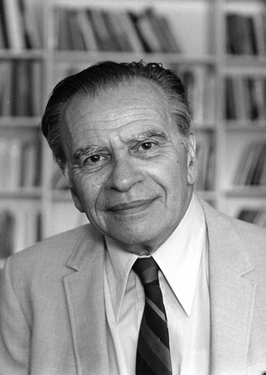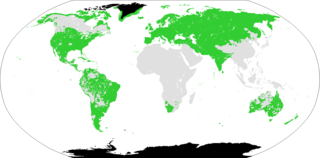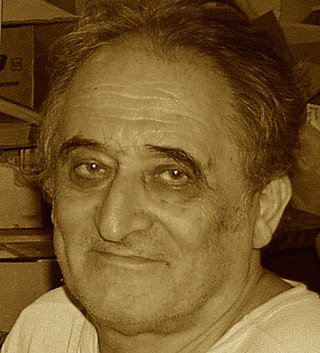
Altaic is a controversial proposed language family that would include the Turkic, Mongolic and Tungusic language families and possibly also the Japonic and Koreanic languages. The hypothetical language family has long been rejected by most comparative linguists, although it continues to be supported by a small but stable scholarly minority. Speakers of the constituent languages are currently scattered over most of Asia north of 35° N and in some eastern parts of Europe, extending in longitude from the Balkan Peninsula to Japan. The group is named after the Altai mountain range in the center of Asia.

Joseph Harold Greenberg was an American linguist, known mainly for his work concerning linguistic typology and the genetic classification of languages.

Ural-Altaic, Uralo-Altaic, Uraltaic, or Turanic is a linguistic convergence zone and abandoned language-family proposal uniting the Uralic and the Altaic languages. It is generally now agreed that even the Altaic languages do not share a common descent: the similarities among Turkic, Mongolic and Tungusic are better explained by diffusion and borrowing. Just as Altaic, internal structure of the Uralic family also has been debated since the family was first proposed. Doubts about the validity of most or all of the proposed higher-order Uralic branchings are becoming more common. The term continues to be used for the central Eurasian typological, grammatical and lexical convergence zone.
Allan R. Bomhard is an American independent scholar publishing in the field of comparative linguistics. He is part of a small group of proponents of the Nostratic hypothesis, according to which the Indo-European languages, Uralic languages, Altaic languages, and Afroasiatic languages would all belong to a larger macrofamily. The theory is widely rejected by mainstream linguists as a fringe theory. Among Nostratists, he has been described as "a maximalist who casts his nets as widely as possible" among far-flung languages not generally believed to be related.

The Chukotko-Kamchatkan or Chukchi–Kamchatkan languages are a language family of extreme northeastern Siberia. Its speakers traditionally were indigenous hunter-gatherers and reindeer-herders. Chukotko-Kamchatkan is endangered. The Kamchatkan branch is moribund, represented only by Western Itelmen, with only 4 or 5 elderly speakers left. The Chukotkan branch had close to 7,000 speakers left, with a reported total ethnic population of 25,000.
Mass comparison is a method developed by Joseph Greenberg to determine the level of genetic relatedness between languages. It is now usually called multilateral comparison. Mass comparison has been referred to as a "methodological deception" and is rejected by most linguists, and its continued use is primarily restricted to fringe linguistics.

Merritt Ruhlen was an American linguist who worked on the classification of languages and what this reveals about the origin and evolution of modern humans. Amongst other linguists, Ruhlen's work was recognized as standing outside the mainstream of comparative-historical linguistics. He was the principal advocate and defender of Joseph Greenberg's approach to language classification.
Vladislav Markovich Illich-Svitych was a Soviet linguist and accentologist. He was a founding father of comparative Nostratic linguistics and the Moscow School of Comparative Linguistics.

Dené–Caucasian is a discredited language family proposal that includes widely-separated language groups spoken in the Northern Hemisphere: Sino-Tibetan languages, Yeniseian languages, Burushaski and North Caucasian languages in Asia; Na-Dené languages in North America; and the Vasconic languages from Europe.

Sergei Anatolyevich Starostin was a Russian historical linguist and philologist, perhaps best known for his reconstructions of hypothetical proto-languages, including his work on the controversial Altaic theory, the formulation of the Dené–Caucasian hypothesis, and the proposal of a Borean language of still earlier date. None of his proposed macrofamilies have seen wide-scale acceptance in the linguistic community, though his proposals remain influential outside of academia. He was also the author of a widely respected reconstruction of Old Chinese.

Eurasiatic is a proposed language macrofamily that would include many language families historically spoken in northern, western, and southern Eurasia.

Indo-Uralic is a highly controversial linguistic hypothesis proposing a genealogical family consisting of Indo-European and Uralic.

Uralo-Siberian is a hypothetical language family consisting of Uralic, Yukaghir, and Eskaleut. It was proposed in 1998 by Michael Fortescue, an expert in Eskaleut and Chukotko-Kamchatkan, in his book Language Relations across Bering Strait. Some have attempted to include Nivkh in Uralo-Siberian. Until 2011, it also included Chukotko-Kamchatkan. However, after 2011 Fortescue only included Uralic, Yukaghir and Eskaleut in the theory, although he argued that Uralo-Siberian languages have influenced Chukotko-Kamchatkan.

Aharon Dolgopolsky, also spelled Aron was a Russian-Israeli linguist who is known as one of the modern founders of comparative Nostratic linguistics.

Borean is a hypothetical linguistic macrofamily that encompasses almost all language families worldwide except those native to the Americas, Africa, Oceania, and the Andaman Islands. Its supporters propose that the various languages spoken in Eurasia and adjacent regions have a genealogical relationship, and ultimately descend from languages spoken during the Upper Paleolithic in the millennia following the Last Glacial Maximum. The name Borean is based on the Greek βορέας, and means "northern". This reflects the fact that the group is held to include most language families native to the northern hemisphere. Two distinct models of Borean exist: that of Harold C. Fleming and that of Sergei Starostin.
Paleolinguistics is a term used by some linguists for the study of the distant human past by linguistic means. For most historical linguists there is no separate field of paleolinguistics. Those who use the term are generally advocates of hypotheses not generally accepted by mainstream historical linguists, a group colloquially referred to as "long-rangers".

Uralic–Yukaghir, also known as Uralo-Yukaghir, is a proposed language family composed of Uralic and Yukaghir.

The Proto-Afroasiatic homeland is the hypothetical place where speakers of the Proto-Afroasiatic language lived in a single linguistic community, or complex of communities, before this original language dispersed geographically and divided into separate distinct languages. Afroasiatic languages are today mostly distributed in parts of Africa, and Western Asia.
The Indo-Semitic hypothesis maintains that a genetic relationship exists between Indo-European and Semitic and that the Indo-European and the Semitic language families both descend from a common root ancestral language. The theory has never been widely accepted by contemporary linguists in modern times, but historically it had a number of supporting advocates and arguments, particularly in the 19th and 20th centuries.
The Moscow School of Comparative Linguistics is a school of linguistics based in Moscow, Russia that is known for its work in long-range comparative linguistics. Formerly based at Moscow State University, it is currently centered at the RSUH Institute of Linguistics, and also the Institute of Linguistics of the Russian Academy of Sciences in Moscow, Russia.














